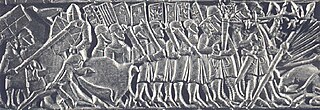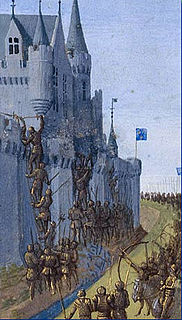
Henry II of Brabant was Duke of Brabant and Lothier after the death of his father Henry I in 1235. His mother was Matilda of Boulogne.

Saint-Pol-sur-Ternoise is a commune in the Pas-de-Calais department in northern France. It is the seat of the canton of Saint-Pol-sur-Ternoise. The population of the town is 4,909 (2019).

The County of Boulogne was a county within the Kingdom of France during the 9th to 15th centuries, centred on the city of Boulogne-sur-Mer. It was ruled by the counts of Flanders in the 10th century, but a separate House of Boulogne emerged during the 11th century. It was annexed by Philip II of France in 1212, after which it was treated as part of the county of Artois until it was finally annexed into the royal domain in 1550.

Charles of Valois, the fourth son of King Philip III of France and Isabella of Aragon, was a member of the House of Capet and founder of the House of Valois, whose rule over France would start in 1328.

Robert I, called the Good, was the first Count of Artois. He was the fifth son of King Louis VIII of France and Blanche of Castile.

The County of Artois was a historic province of the Kingdom of France, held by the Dukes of Burgundy from 1384 until 1477/82, and a state of the Holy Roman Empire from 1493 until 1659.

The Burgundian Circle was an Imperial Circle of the Holy Roman Empire created in 1512 and significantly enlarged in 1548. In addition to the Free County of Burgundy, the Burgundian Circle roughly covered the Low Countries, i.e., the areas now known as the Netherlands, Belgium and Luxembourg and adjacent parts in the French administrative region of Nord-Pas-de-Calais. For most of its history, its lands were coterminous with the holdings of the Spanish Habsburgs in the Empire.

Guy III of Châtillon, Count of Saint-Pol was a French nobleman, and was a younger son of Hugh I, Count of Blois, and Mary, Countess of Blois.
Guy IV of Châtillon, Count of Saint Pol was a French nobleman. He was the son of Guy III, Count of Saint-Pol and Matilda of Brabant.

The House of Valois-Burgundy, or the Younger House of Burgundy, was a noble French family deriving from the royal House of Valois. It is distinct from the Capetian House of Burgundy, descendants of King Robert II of France, though both houses stem from the Capetian dynasty. They ruled the Duchy of Burgundy from 1363 to 1482 and later came to rule vast lands including Artois, Flanders, Luxembourg, Hainault, the county palatine of Burgundy (Franche-Comté), and other lands through marriage, forming what is now known as the Burgundian State.

Matilda of Brabant was the eldest daughter of Henry II, Duke of Brabant and his first wife Marie of Hohenstaufen.
Marie of Brittany (1268–1339) was the daughter of John II, Duke of Brittany, and Beatrice of England. She is also known as Marie de Dreux.

The House of Châtillon was a notable French family, with origins in the 9th century. The name comes from that of Châtillon-sur-Marne in Champagne, where members of the family were tenants in a castle belonging to the Counts of Champagne. Gaucher V of Châtillon was lord of Châtillon from 1290 until 1303, when he became count of Porcien; the title was sold to Louis of Valois, Duke of Orléans in 1400. Other branches of the family were in Saint-Pol-sur-Ternoise, in Blois, and in Penthièvre.

The Burgundian inheritance in the Low Countries consisted of numerous fiefs held by the Dukes of Burgundy in modern-day Belgium, Netherlands, Luxembourg, and in parts of France and Germany. The Duke of Burgundy was originally a member of the House of Valois-Burgundy and later of the House of Habsburg. Given that the Dukes of Burgundy lost Burgundy proper to the Kingdom of France in 1477, and were never able to recover it, while retaining Charolais and the Free County of Burgundy, they moved their court to the Low Countries. The Burgundian Low Countries were ultimately expanded to include Seventeen Provinces under Charles V, Holy Roman Emperor. The Burgundian inheritance then passed to the Spanish branch of the Habsburgs under Philip II of Spain, whose rule was contested by the Dutch revolt, and fragmented into the Spanish Netherlands and the Dutch republic. Following the War of the Spanish succession, the Habsburg Netherlands passed to Austria and remained in Austrian hands until the French conquest of the late 18th century. The Bourbon Restoration did not re-establish the Burgundian states, with the former Burgundian territories remaining divided between France, the Netherlands and, following the Belgian Revolution, modern-day Belgium.

The Franco-Flemish War was a conflict between the Kingdom of France and the County of Flanders between 1297 and 1305.

William II, Lord of Béthune, nicknamed William the Red was French nobleman. He was a ruling Lord of Béthune, Richebourg and Warneton, as well as hereditary advocatus of the Abbey of St. Vaast, near Arras.
Waleran III of Luxembourg Count of Ligny and Saint Pol, was a French nobleman and soldier.

Guy IV (c. 1197 – 1226) of the House of Châtillon was the de facto count of Saint-Pol as Guy II from 1219/1223 until his death.

Elizabeth, in French Élisabeth Candavène, was the countess of Saint-Pol from 1205 until her death, although her effective rule was limited to the periods 1219–1222 and 1226–1227. The rest of the time the county was ruled by her first husband and by her sons. From 1196 to 1219, she was married to Lord Gaucher III of Châtillon. From 1228 until 1238, she was married to the landless John of Béthune. She was a patroness of the Cistercians.



















